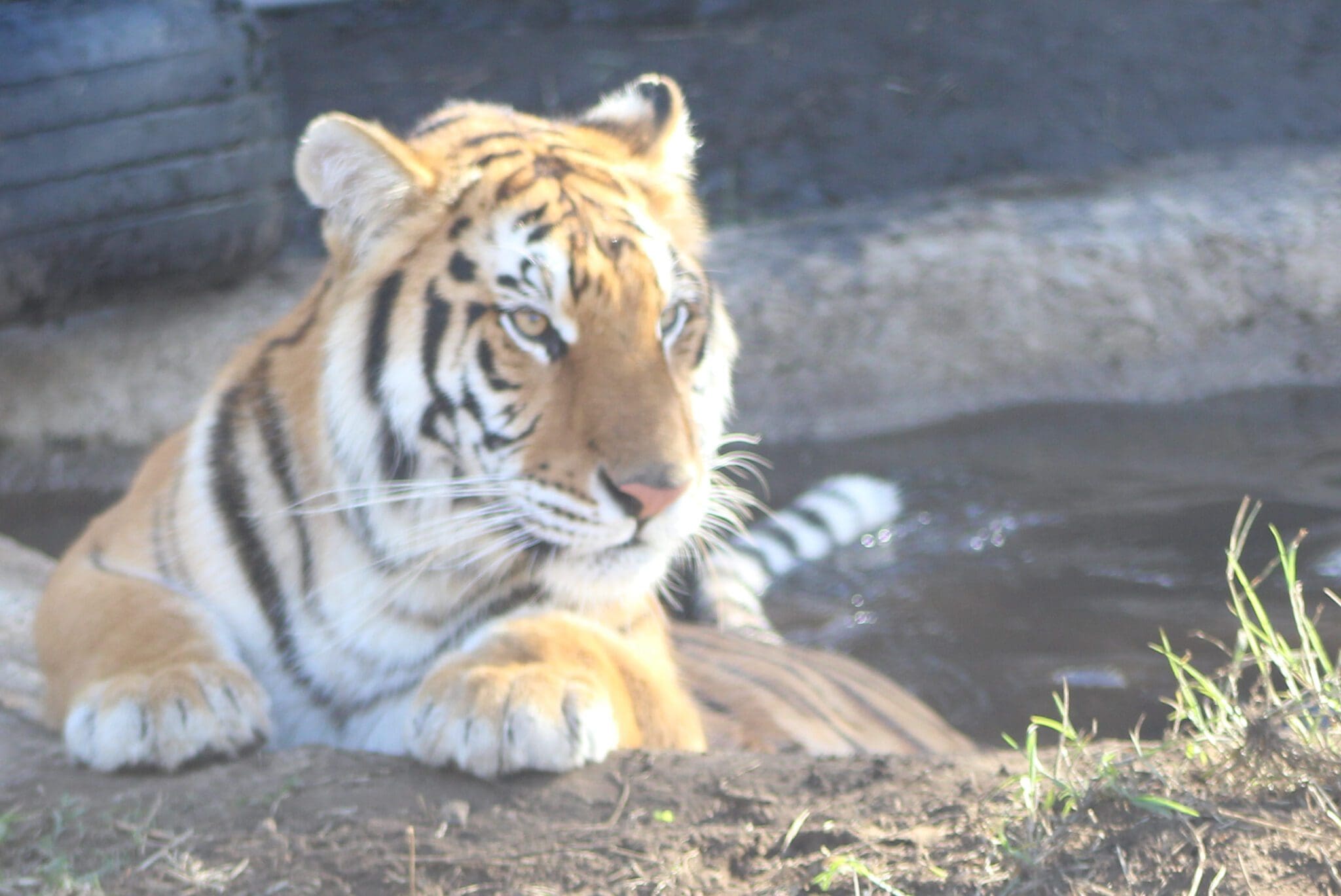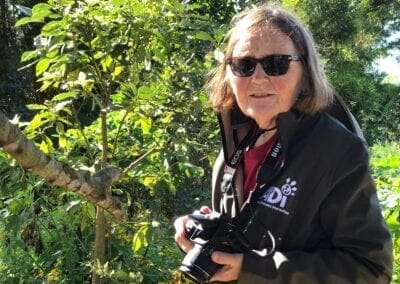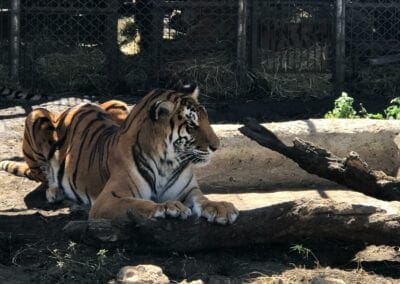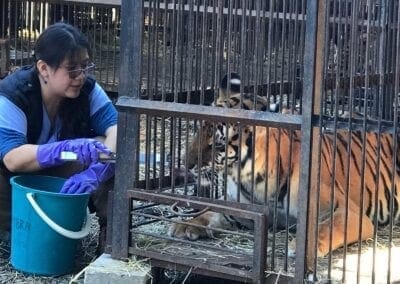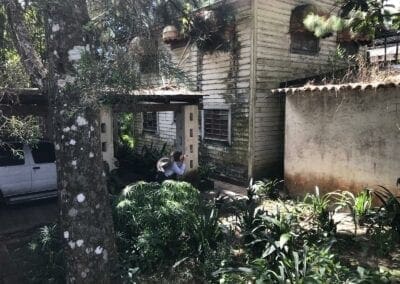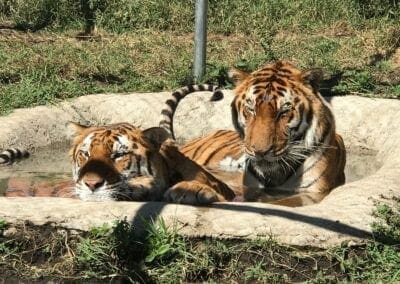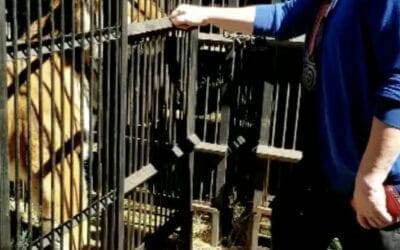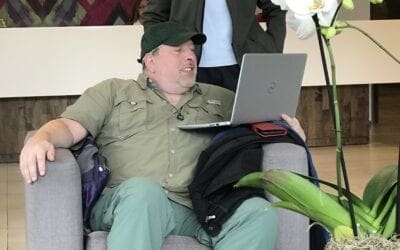After the long drive out of the city, through a maze of streets and byways, crowded communities and rural areas, over nice highways and unpaved roads, we finally stop. Our driver jumps out and shouts, and somewhere from the opposite side of a wall a large section slides open. We’re here.
We have arrived at long last at the Animal Defenders International (ADI) Temporary Rescue Center, where over the past many months each rescued lion and tiger has been thoroughly evaluated, cared for and brought back to health. They have finally received treatment for painfully broken teeth, atrophied muscles, malnourishment and trauma they received at human hands.
Here at the Rescue Center they have discovered the joy in playing, laying in the sun, smelling the grass beneath their feet, being with their families and companions, enjoying healthy food, clean homes and clear water.
Mary and I have come all this way to witness what caring can do.
I step down from the truck into the rescue center feeling a little disoriented. It seems, at first, that we’re in the middle of the jungle. Then, through a tall line of trees, I begin to recognize the village of night cages where the lions and tigers are fed and monitored. Behind the night cages I can make out the large fenced-in runs where they live and play.
Men begin emerging from several different directions at once, all moving towards us. At the back of the small house that looks like it grew straight out of the undergrowth, a single dog stands at alert, on duty. His large tail wags welcome. I turn to the sound of a voice. A thin young woman moves towards us swiftly through patches of sunlight that bounce off her ADI hat and t-shirt. She arrives at the truck with a smile. Hand outstretched. This is Yani, ADI’s Temporary Rescue Center Manager, and other go-to person on the ground. Her presence clearly commands the scene.
Jan and Tim introduce us. Yani acknowledges Mary and me warmly and then, without missing a beat, begins updating them on the status of whatever has occurred since their last conversation. While I know nothing of the content, nor should I, what strikes me is the professionalism of the exchange. They are colleagues, urgently working together toward something larger than themselves. It is the well-being of their charges, these 17 lions and tigers, and getting them to the ADI Wildlife Sanctuary in South Africa as quickly and safely as possible that matters.
Both Mary and I relate. We get it. We have both worked in jobs where lives are on the line. The AIDS Epidemic saw each of us deeply engaged in different fronts of the same struggle – Mary was in the labs – I was in the streets. We are here to watch and learn, to photograph and record, to help when and where we can and be part of the solution, not add to the problems. We stand quietly to the side taking in the scope of the operation until Jan is ready to move toward the animals.
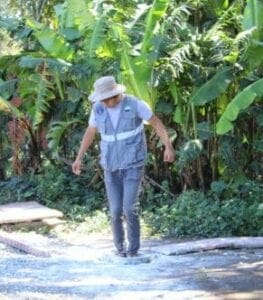 We follow along a narrow trail that stops at a container of lye set into the ground. The lye is a disinfectant to keep us from contaminating the area with something we track in and also keep us from taking any contamination away with us. We step down into it making sure both feet are dusted. No one here takes chances.
We follow along a narrow trail that stops at a container of lye set into the ground. The lye is a disinfectant to keep us from contaminating the area with something we track in and also keep us from taking any contamination away with us. We step down into it making sure both feet are dusted. No one here takes chances.
We enter a large clearing where the animals live and are treated. It is an active village where everyone knows their job and all the focus is on the well-being of each great cat. We come around the empty night cages to the runs to meet the tigers and I am unexpectedly stunned by the ocean of stripes churning before me.
These are huge animals, spinning and charging one another, leaping, playing – an explosion of crisp, bright whites and blacks and yellows that are at once majestic and overwhelming. My senses are momentarily staggered by being exposed to more stripes than I have seen in my life.
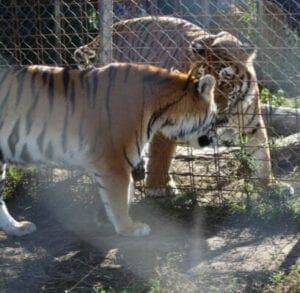 The tigers are regal, magnificent, awesome and… everywhere. “How am I ever going to tell them apart?” I wonder, concerned and a little ashamed. It’s not that “they all look the same” – but they actually do. My brain hasn’t had enough exposure to them to be able to decipher the elaborate patterning that delineates one from another. I know the stripes form their unique signatures but we haven’t been introduced. I don’t know their names.
The tigers are regal, magnificent, awesome and… everywhere. “How am I ever going to tell them apart?” I wonder, concerned and a little ashamed. It’s not that “they all look the same” – but they actually do. My brain hasn’t had enough exposure to them to be able to decipher the elaborate patterning that delineates one from another. I know the stripes form their unique signatures but we haven’t been introduced. I don’t know their names.
Gwynne used to say: “If I know your name, then…” then everything changes. Each one of these beautiful tigers has a name, a story. I am eager to get to know them – together and individually.
Gradually I realize that a few are moving oddly. Stiff-legged. Rocking. I notice where a tail is truncated or crooked. I begin to understand the cost of inbreeding and captivity that is on display.
As I stand there thinking, two of the youngsters are let out to play. They head straight for the pond in the middle of their large enclosure. They’re in the water in a flash – jumping and playing, stalking and splashing, just sitting in the water like little kids grinning. I see how they love the pond, how natural it is for them to be in it, and my heart aches with the grief that not one of them has known the joy of water until ADI created these ponds for them.
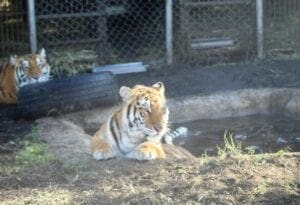 While I have been lost in my thoughts one of the two has come to the fence directly in front of me. She snorts and sniffs. I bend down and offer her the back of my hand. She snuffles it through the fence. I resist the impulse to put my hand in to pet her. As sweet as this moment is, she is a wild animal and capable of doing great damage unintentionally to a creature as frail and flimsy as me. If she hurt me it is she, sadly, who would pay. In any other setting it would cost her life. I am touched and sobered at how curious and trusting she is in this moment, at how powerful the drive is to connect to another.
While I have been lost in my thoughts one of the two has come to the fence directly in front of me. She snorts and sniffs. I bend down and offer her the back of my hand. She snuffles it through the fence. I resist the impulse to put my hand in to pet her. As sweet as this moment is, she is a wild animal and capable of doing great damage unintentionally to a creature as frail and flimsy as me. If she hurt me it is she, sadly, who would pay. In any other setting it would cost her life. I am touched and sobered at how curious and trusting she is in this moment, at how powerful the drive is to connect to another.
The lions appear in the far enclosures. They climb up on their platforms and relax in the sun. I will go to them soon enough, but for now, my heart belongs to the tigers.

